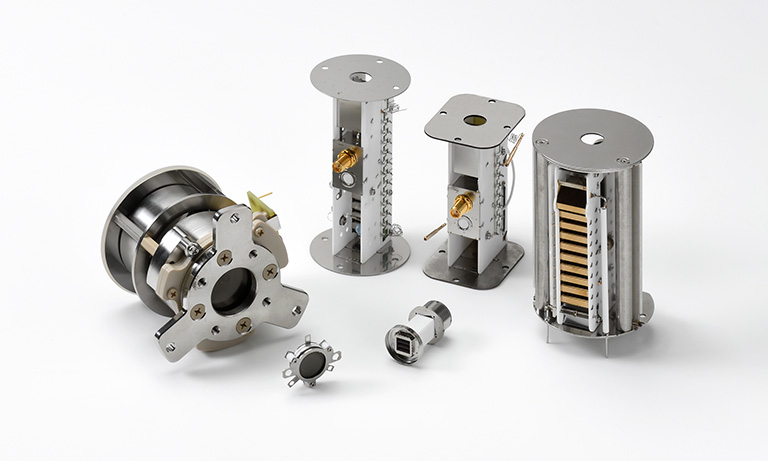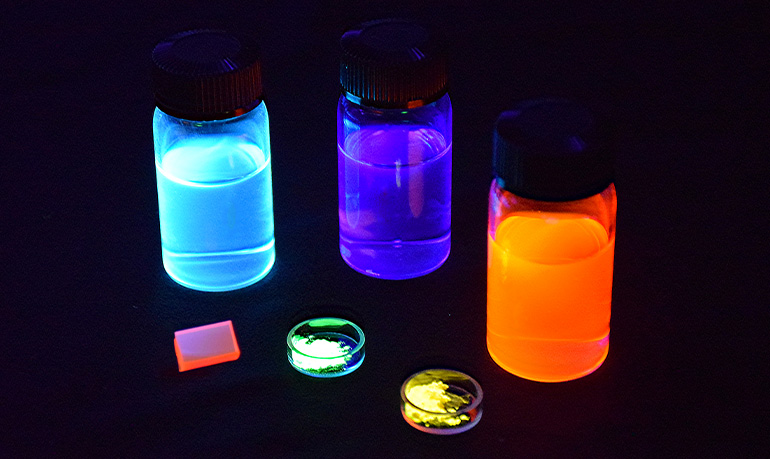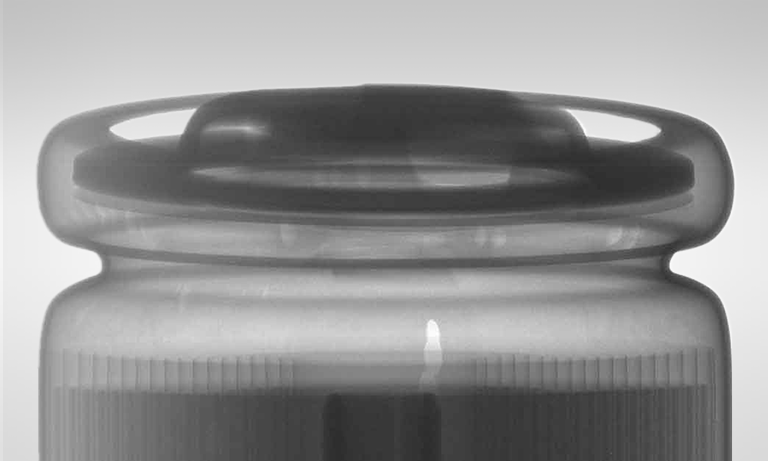Signal-to-Noise Ratio (SNR) is a figure of merit that is used to describe how
discernable the signal is from the noise. In principle SNR must be at least greater than 1 in order to
be measure an input.
How to use the simulator:
1. Choose your detector type, up to five detectors can be compared simultaneously (Detector A to E)
2. Input your detector specifications, or simply choose a preset detector from the dropdown menu.
3. Adjust the global parameters such as light input conditions flux \(photons \over second \) or flux
density \(photons \over sec*sq. millimeter \), and noise current and voltage RMS
4. If you are using a preset detector, the sensitivity will change automatically when you change the
wavelength. Please note that adjusting any of the specifications will override the preset and disable
the sensitivity vs. wavelength estimating function.
This simulation should be regarded as a reference only, no guarantee of
detector performance is implied by the results of this simulation.
Please contact our Applications
Engineers by submitting a web inquiry or by calling the Hamamatsu technical support line for a more
thorough and in-depth simulation and detector selection.
How to calculate SNR:
SNR Equation
This simulator calculates the SNR using the following general equation: $$ SNR = { I_S \over { \sqrt{ 2 q (I_{S} + I_{D}) \mu F \Delta f + {{4 k_B T \Delta f} \over R_f} + [e_n \sqrt{\Delta f} ({1 \over R_f} + 2 \pi \Delta f C_t)]^2 + [i_n \sqrt{\Delta f}]^2 } } } $$ The signal current is the cathode photocurrent multiplied by the intrinsic gain \( \mu \) of the detector. The \( \mu \) term is ommited for detectors without gain such as photodiodes and phototubes. $$ I_S = I_k \mu $$ \( I_k \), the cathode photocurrent is calculated from the photon arrival rate \( \Phi_p \) multiplied by the quantum efficiency \(\eta\) and the fundamental charge \( q\). $$ I_k = \Phi_p \eta q $$ Additionally for PMT the signal current is scaled by the collection efficiency \( \alpha \). The collection efficiency is the probability that the electrons generated at the photocathode will reach the 1st dynode and subsequently the rest of the dynode chain. $$ I_S = I_k \mu \alpha $$ The signal current calculation is slightly different for MPPC. The sensitivity of the MPPC is given by its photon detection efficiency which is a product of the quantum efficiency, the fill factor \( F_g \), and the Geiger discharge probability \( P_g\). The fill factor is the fraction of sensitive area within the microcell, the other fraction being occupied by non-sensitive structures such as metal trenches. The Geiger discharge probability is the likelihood that the primary photoelectron triggers the avalanche multiplication. $$ PDE = \eta F_g P_g $$ Thus the anode current from the MPPC is given by the equation. $$ I_S = \Phi_p \eta F_g P_g q \mu $$Intrinsic Noise
The intrinsic noise of the detector is the combined noise contribution of signal shot noise and dark shot noise. $$ \sigma_{det}^2 = {2q(I_S + I_D)\mu F \Delta f} $$ \(F\) is the excess noise factor of the detector. It is used to account for the increase in noise due to the fluctuation in gain. For detectors without gain such as photodiodes \(F\) is equal to 1.\( \Delta f\) is the bandwidth of the measurement circuit
\( I_D \) is the anode dark current.
Excess Noise Factor for PMT:
In PMT if the distribution of gain from each dynode is assumed to be Poissonian, then it can be shown that the variance of the first dynode is roughly the variance of the entire PMT. Assuming the gain of the PMT is evenly distributed between each dynode, we can estimate the gain of the first dynode using \(\delta_{dy1}=M^{1 \over {dynodes}}\) then the excess noise factor can be estimated. $$ F_{pmt} ={ \delta_{dy1} \over {\delta_{dy1} - 1}} $$Excess Noise Factor for APD:
The probability mass function of APD excess noise was derived by McIntyre [1] for \(m\) number of multiplied electrons resulting from \(n\) initial electrons with an average gain \( \mu \) and ionization ratio \(k\). $$ p(m | n) = {{n \Gamma({m \over {1-k}}+1)} \over m(m-n)! \Gamma({{km \over {1-k}}+n+1})} \left[{{1+k(\mu-1)}\over \mu}\right]^{n+km/(1-k)} {\left[{{(1-k)(\mu-1)}\over \mu}\right]^{m-n}} $$ A simplified approximation was derived by Webb et al. [2]. However, it should be noted this approximation is not a true probability mass function as it does not sum to one and it is known that the approximate distribution deviates from McIntyre's exact probability density function for \(m \lt 10 \) output electrons, but nevertheless it is a useful approximation. $$ p(m|n) = { {1 \over { \sqrt{2 \pi n \mu^2 F} (1+ {{m-\mu n}\over{n \mu F/(F-1)}})^{3/2} }} \exp{\left[ -{(m-\mu n)^2} \over {2 n M^2 F (1+{{m-\mu n} \over n \mu F/(F-1)})} \right]} } $$ Here the Excess Noise Factor is defined as a function of the ionization ratio and gain as \(F=kG+(2-{1\over G})(1-k) \). Further simplification is achieved by measuring \(F\) values at varying gain settings. The formula from empirical approximation is provided below, here the term \(x\) is excess noise index the measured value provided by the manufacturer. $$ F_{apd} = \mu ^x $$Excess Noise Factor for SiPM (MPPC):
A primary source of multiplication noise in SiPM (MPPC) is optical crosstalk, which results from secondary photons emitted during the avalanche migrating to another microcell and triggering a secondary avalanche. The probability of N microcells fired as a result of exactly one initial microcell fired is shown to have a Borel distribution by Vinogradov [3]. The Borel distribution can be written in terms of SiPM parameters as such. $$ P_{\mu}(N)= {{\exp(-\mu N)(\mu N)^{N-1}} \over N!} $$ Where \(\mu=-ln(1-P_{ct})\), the expected value of Borel distributed random numbers is \(1 \over {1- \mu}\). Thus we get an approximation for excess noise factor of SiPM (MPPC) as a function of crosstalk probability \(P_{ct}\). $$ F_{sipm} = {1 \over {1+ln(1-P_{ct})}} $$External Noise
The external noise contributed by the readout circuit is composed of three main parts. The Johnson noise is the thermal noise generated by the feedback resistor \( R_f \) in a transimpedance amplifier. \( k_B \) is the Boltzmann constant \(1.38*10^{-23}\) Joule/Kelvin. \( T \) is the temperature in Kelvin. $$ {\sigma_J}^2 = {{4 k_B T \Delta f} \over R_f}$$ The input referred broadband noise current resulting from the amplifier's voltage noise. \( e_n \) is the broadband input noise voltage density. The circuit forms a non-inverting amplifier for the input noise voltage with a gain of equal to \( 1 + {R_f \over Z_{C_{in}}}\), where \( Z_{C_{in}} = {1 \over 2 \pi \Delta f C_{in}}\) the impedance of the parallel combination of the terminal capacitance \(C_t\) and the op-amp input capacitance \(C_{oa}\). $$ {\sigma_{v_n}}^2 = \left[e_n \sqrt{\Delta f} ({1 \over R_f} + 2 \pi \Delta f C_{in}) \right]^2 $$ The input referred broadband noise current resulting from the amplifier's current noise. \(i_n\) is the broadband input noise current density. $$ {\sigma_{i_n}}^2 = \left[i_n \sqrt{\Delta f} \right]^2 $$ As an option, the simulator can account for low frequency noise. This introduces two additional noise terms. \( e_{n_{1Hz}} \) is the voltage noise density at 1Hz. \( i_{n_{1Hz}} \) is the current noise density at 1Hz. \( f_{Hi} \) is the high frequency cutoff. \( f_{Lo} \) is the low frequency cutoff. $$ {\sigma_{n_{1Hz}}}^2 = \left[e_{n_{1Hz}} \sqrt{LN \left( {f_{Hi} \over f_{Lo}} \right)} ({1\over R_f} + 2 \pi \Delta f C_{in}) \right]^2 $$ $$ {\sigma_{n_{1Hz}}}^2 = \left[ i_{n_{1Hz}} \sqrt{LN \left( {f_{Hi} \over f_{Lo}} \right)} \right] ^2 $$ References[1] R. J. McIntyre, "The Distribution of Gains in Uniformly Multiplying Avalanche Photodiodes: Theory," IEEE Transactions on Electron Devices, vol. ED-19, pp.703-713, June 1972.
[2] P. P. Webb, R. J. McIntyre, and J. Conradi, "Properties of Avalanche," RCA Review, vol. 35, pp. 234-278, June 1974.
[3] S. Vinogradov, "Analytical Models of Probability Distribution and Excess Noise Factor of Solid State Photomultipier Signals with Crosstalk," Nuclear Inst. and Methods in Physics Research, A, Volume 695, p. 247-251, Dec. 2012.


























































































































